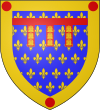Pas-de-Calais
| Pas-de-Calais | ||
|---|---|---|
| Department | ||

Prefecture building of the Pas-de-Calais department, in Arras
|
||
|
||
 Location of Pas-de-Calais in France |
||
| Coordinates: 50°57′N 1°51′E / 50.950°N 1.850°ECoordinates: 50°57′N 1°51′E / 50.950°N 1.850°E | ||
| Country | France | |
| Region | Hauts-de-France | |
| Prefecture | Arras | |
| Subprefectures | Béthune, Boulogne-sur-Mer, Calais, Lens, Montreuil, Saint-Omer | |
| Government | ||
| • President of the General Council | Michel Dagbert | |
| Area | ||
| • Total | 6,671 km2 (2,576 sq mi) | |
| Population (2013) | ||
| • Total | 1,465,205 | |
| • Rank | 8th | |
| • Density | 220/km2 (570/sq mi) | |
| Time zone | CET (UTC+1) | |
| • Summer (DST) | CEST (UTC+2) | |
| Department number | 62 | |
| Arrondissements | 7 | |
| Cantons | 39 | |
| Communes | 892 | |
| ^1 French Land Register data, which exclude estuaries, and lakes, ponds, and glaciers larger than 1 km2 | ||
Pas-de-Calais (French pronunciation: [pɑ d(ə) kalɛ]) is a department in northern France. Its name is also used in French to refer to the Strait of Dover, which it borders, and comes from the older Norman English usage of the Pale of Calais.
Inhabited since prehistoric times, the Pas-de-Calais region was populated in turn by the Celtic Belgae, the Romans, the Germanic Franks and the Alemanni. During the fourth and fifth centuries, the Roman practice of co-opting Germanic tribes to provide military and defence services along the route from Boulogne to Cologne created a Germanic-Romance linguistic border in the region that persisted until the eighth century.
Saxon colonization into the region from the fifth to the eighth centuries likely extended the linguistic border somewhat south and west so that by the ninth century most inhabitants north of the line between Béthune and Berck spoke a dialect of Middle Dutch, while the inhabitants to the south spoke Picard, a variety of Romance dialects.
This linguistic border is still evident today in the toponyms and patronyms of the region. Beginning in the ninth century, the linguistic border began a steady move to north and the east, and by the end of the 15th century Romance dialects had completely displaced those of Dutch.
...
Wikipedia

